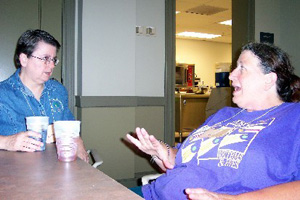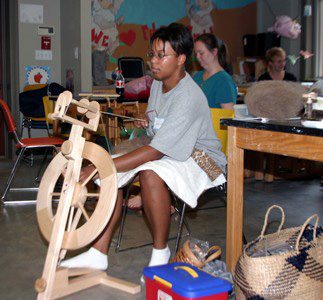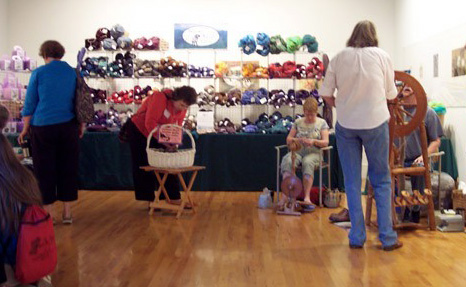Let's Produce A Major
Fiber Arts Festival.
It'll Only Take A Year (or Two) to Do It.
One weekend. Over
thirty classes offered by master teachers,
ranging from Spinning Ancient Sheep Breeds
to Card Weaving. Lots of vendors
selling fabulous fiber things. Door prizes
donated by major yarn companies. Goody bags
for each participant. Lunch. And logistics
galore.
We all love to go to these
events. We dream and obsess about these events.
But do we ever think about what it takes it
get it done?
Producing an event of this
magnitude requires a mighty effort on the
part of the organizers and dozens of volunteers.
This year's Plying the Arts, held at
the Lyndon House Arts Center in Athens, Georgia,
featured over 70 participants from 6 states;
14 teachers; and 20 volunteers. The planning
process began nearly two years before the
event, which was held August 5-6, 2006.
|

Margaret Heathman
is an author, designer, teacher, yarn
shop owner, mentor, and creativity coach.
Her book, Knitting Languages,
is sold around the world, and her designs
can be found in craft stores throughout
the US. Margaret has taught at Plying
the Arts, Southeastern Animal Fiber
Fair (Asheville, NC), Southeast Fiber
Forum Association conferences, at guilds
and private organizations throughout
the southeast.
Paula J. Vester has
been spinning for 25 years, but has
been interested in history and the collection
of information all her life. As a teacher,
storyteller, and demonstrator, she shares
not only the skills of spinning, dyeing,
crochet, and simple weaving, but also
the folklore and history of the people
who worked in textiles. Through her
company, World in A Spin, she publishes
her own books, as well as those of other
artists.
Margaret and Paula
outlined the basic stages of the process.
Both are authors, as well as gifted
practitioners and teachers of multiple
fiber arts disciplines. These unique
abilities contributed to their success
with planning and executing an event
for fiber aficionados.
|
Margaret Heathman and Paula
Vester, two leading lights of the Peachtree
Handspinners Guild of Atlanta, Georgia,
are veteran fiber event organizers. Margaret
has masterminded two previous Plying the Arts
weekends, and agreed to do it one more time
if organizational-wizard Paula would pitch
in.
Step 1: Schedule
the date . Paula and Margaret carefully
identified the dates of other major fiber
national and regional events in order to avoid
conflicts. Other considerations: school start
date, the weather.
Step 2: Find the
perfect location . This took some research.
The regular venue for monthly guild meetings
was unsuitable due to lack of air conditioning
in parts of the building (a critical consideration
during Georgia summers!) The Lyndon
House Arts Center, built in 1850, has
gallery space, vendor area, class rooms, and
excellent air conditioning! The Arts Center
also hosts the Athens Fiber Craft Guild, and
was delighted to offer the facility for Plying
the Arts.
Step 3: Figure
out the budget . First, Paula did income
projections based on class fees, vendor fees,
and lunch purchases. There were no monetary
donations or sponsorships. After calculating
projected income, Paula came up with a cost
per class for members and nonmembers of the
guild.
Expenses included teacher fees, lunch costs,
postage, paper and printing, and a donation
to the Arts Center for use of the facility.
Also, canvas project bags (with the Plying
the Arts logo) were purchased to give to each
participant along with donated products (goody
bags).
Margaret's hope for that
the event would produce enough funds after
expenses for the guild to have seed money
for a special workshop were realized. Her
dream is to bring Judith McKenzie McCuin to
Atlanta for a weekend seminar.

 Step
4: Find the teachers/plan the classes.
Rule of the game for Plying the Arts: all
teachers MUST be guild members. When asked
why she agreed to produce the event, Margaret
said, "We have an astonishing number
of true masters of many fiber arts in our
own guild. There isn't enough time at our
monthly meetings for them to share their knowledge.
Plying the Arts offers intensive classes as
an additional opportunity to learn from our
members."
Step
4: Find the teachers/plan the classes.
Rule of the game for Plying the Arts: all
teachers MUST be guild members. When asked
why she agreed to produce the event, Margaret
said, "We have an astonishing number
of true masters of many fiber arts in our
own guild. There isn't enough time at our
monthly meetings for them to share their knowledge.
Plying the Arts offers intensive classes as
an additional opportunity to learn from our
members."
To determine what classes
to offer, Paula and Margaret identified general
categories, such as spinning, beading, knitting,
weaving, dyeing. They considered previous
Plying the Arts class evaluations, as well
as guild member requests. Then they matched
the topics with teacher abilities. They approached
guild member/teachers and asked them to submit
proposals to offer a class.
Then she began the exacting
task of matching teachers' schedules and classes

 Step
5: Find the sponsors and vendors. Write
a lot of letters to "everyone you can
think of." Surprise large donations included
an Incredible Sweater Machine from Caron Yarns
and a week-long class at the John C. Campbell
Folk School.
Step
5: Find the sponsors and vendors. Write
a lot of letters to "everyone you can
think of." Surprise large donations included
an Incredible Sweater Machine from Caron Yarns
and a week-long class at the John C. Campbell
Folk School.
Vendors were asked to donate
one item for a door prize. This is a popular
feature of Plying the Arts. Each registrant
gets one door prize ticket and can purchase
more. Drawings are held both days.
|
I
Feel Like a Number
Number
of people who work to make this happen:
About 20 plus the two organizers
Number
of hours it takes to make it happen:
An average of 20 hours/week
for one year; about 1040 hours
A quote from Paula:
"...and then for the last month
I obsess about it 24 hours/day."
That equals another 720 hours.
Number
of people that come to take classes
and shop:72 registered students
100+ more come to just shop
Number
of class sessions: 180
Number
of class hours: approximately
84
Number
of gallons of beverages consumed:
14 gallons of coffee, tea, or lemonade
|
Step 6: Get
the paperwork done. This means
registration brochures, letters to vendors,
thank you notes, maps, hotel information, tent
cards, and instructions for vendors.
Step 7: Get the
word out. Brochures have to be printed
and mailed. The guild and Paula's website
were updated with class and registration information.
Step 8: Registrations
roll in. Paula devised a system to process
them and began to create the class schedule.
Brochures went out the first week in May;
registration was closed by July 6!
Step 9: Recruit
the volunteers. Jobs for volunteers include
parking cars, lunch service and cleanup, and
working the registration desk. Most are guild
members.
Step 10: Show up
and stay on your feet for two days to make
sure everything goes as planned!
Step
11: Spend a few days recovering. Then
the organizers produce final reports, thank
you notes, and financial reports to the guild
that include payments to teachers and the
facility. This is the time to wrap up all
the details and review the class evaluations
to see what can be done better next time!

